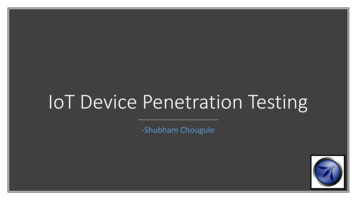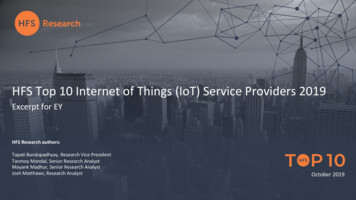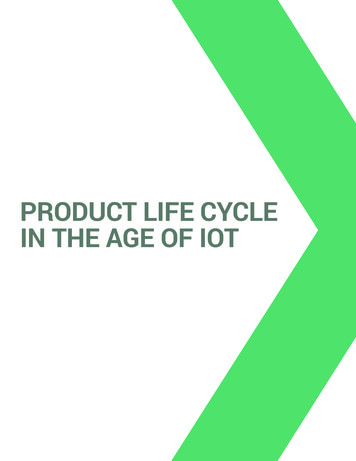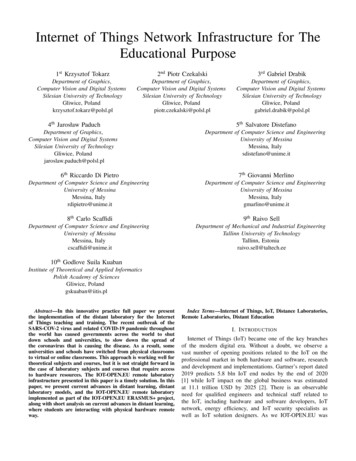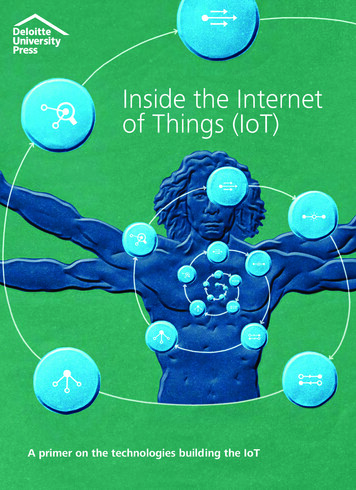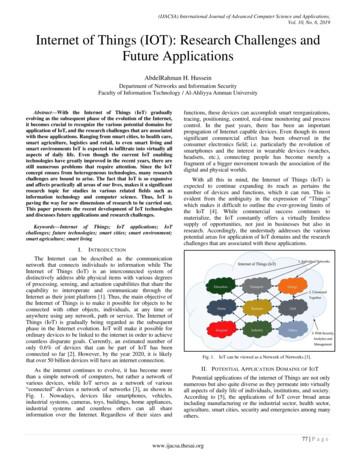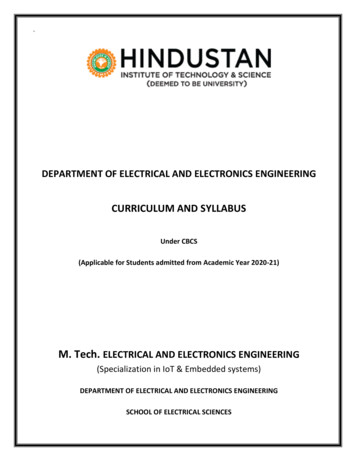
Transcription
DEPARTMENT OF ELECTRICAL AND ELECTRONICS ENGINEERINGCURRICULUM AND SYLLABUSUnder CBCS(Applicable for Students admitted from Academic Year 2020-21)M. Tech. ELECTRICAL AND ELECTRONICS ENGINEERING(Specialization in IoT & Embedded systems)DEPARTMENT OF ELECTRICAL AND ELECTRONICS ENGINEERINGSCHOOL OF ELECTRICAL SCIENCES
CURRICULUM AND SYLLABUS M.TECH –EEE -Specialization in IoT & Embedded systemsHINDUSTAN INSTITUTE OF TECHNOLOGY & SCIENCEVISION AND MISSIONMottoTo Make Every Man A Success And No Man A FailureVisionTo be an International Institute of Excellence, providing a conducive environment for education with a strongemphasis on innovation, quality, research and strategic partnership blended with values and commitment to society.Mission To create an ecosystem for learning and world class research. To nurture a sense of creativity and innovation. To instill highest ethical standards and values with a sense of professionalism. To take up activities for the development of Society. To develop national and international collaboration and strategic partnership with industry and institutes ofexcellence. To enable graduates to become future leaders and innovators.DEPARTMENT OF ELECTRICAL AND ELECTRONICS ENGINEERINGVISION AND MISSIONVision of the DepartmentTo educate the students in the recent developments of emerging fields in Electrical and ElectronicsEngineering, to encourage research activities, innovative techniques and to develop managerial abilitiesso as to make them excel globally with ethical values.Mission of the DepartmentM1: To empower students with state-of-art Knowledge and Technological skills in Electrical andElectronics Engineering.M2: To upgrade curriculum continuously to meet the Emerging Industrial Requirement.M3: To mould students for Research, Innovation and Entrepreneurship.M4: To inculcate Managerial and Professional capabilities with Ethics and Human values.1
CURRICULUM AND SYLLABUS M.TECH –EEE -Specialization in IoT & Embedded systemsM. Tech. Electrical and Electronics EngineeringSpecialization in IoT and Embedded systemsPROGRAMME EDUCATIONAL OBJECTIVES (PEO)The program is expected to enable the students toPEO I Design and develop innovative products and services in the field of IoT and embeddedsystemsPEO II keeps abreast with the latest technology and toolset.PEO III Communicate effectively to propagate ideas and promote teamworkPEO IV Attain intellectual leadership skills to cater to the changing needs of power industry,academia, society and environmentPROGRAM OUTCOMES (PO)At the end of this program, graduates will be able to1. A knowledge base for engineering: Demonstrated competence in university levelmathematics, natural sciences, engineering fundamentals, and specialized engineeringknowledge appropriate to the program.2. Problem analysis: An ability to use appropriate knowledge and skills to identify, formulate,analyze, and solve complex engineering problems in order to reach substantiated conclusions3. Investigation: An ability to conduct investigations of complex problems by methods thatinclude appropriate experiments, analysis and interpretation of data and synthesis of informationin order to reach valid conclusions.4. Design: An ability to design solutions for complex, open-ended engineering problems andto design systems, components or processes that meet specified needs with appropriateattention to health and safety risks, applicable standards, and economic, environmental, culturaland societal considerations.5. Use of engineering tools: An ability to create, select, apply, adapt, and extendappropriate techniques, resources, and modern engineering tools to a range of engineeringactivities, from simple to complex, with an understanding of the associated limitations.6. Individual and teamwork: An ability to work effectively as a member and leader inteams, preferably in a multi-disciplinary setting.7. Communication skills: An ability to communicate complex engineering concepts withinthe profession and with society at large. Such ability includes reading, writing, speaking andlistening, and the ability to comprehend and write effective reports and design documentation,and to give and effectively respond to clear instructions.8.Professionalism: An understanding of the roles and responsibilities of the professionalengineer in society, especially the primary role of protection of the public and the public interest.9. Impact of engineering on society and the environment: An ability to analyze social and2
CURRICULUM AND SYLLABUS M.TECH –EEE -Specialization in IoT & Embedded systemsenvironmental aspects of engineering activities. Such ability includes an understanding of theinteractions that engineering has with the economic, social, health, safety, legal, and culturalaspects of society, the uncertainties in the prediction of such interactions; and the concepts ofsustainable design and development and environmental stewardship.10. Ethics and equity: An ability to apply professional ethics, accountability, and equity.11. Economics and project management: An ability to appropriately incorporate economicsand business practices including project, risk, and change management into the practice ofengineering and to understand their limitations.12. Life-long learning: An ability to identify and to address their own educational needs in achanging world in ways sufficient to maintain their competence and to allow them to contributeto the advancement of knowledgePROGRAM SPECIFIC OUTCOMES (PSO).PSO1: An ability to design and develop environmental friendly IoT enabled embedded devices.PSO2: To introduce application of embedded systems for conversion, control and automation.PSO3: Apply appropriate techniques and modern Engineering hardware and software tools in IoTenabled embedded devices to engage in life- long learning and to successfully adapt inmulti-disciplinary environments.PSO4: Understand the impact of Professional Engineering solutions in societal andenvironmental context, commit to professional ethics and communicate effectively.3
CURRICULUM AND SYLLABUS M.TECH –EEE -Specialization in IoT & Embedded systemsM.TECH – EEE -Specialization in IoT & Embedded systems(65 CREDIT STRUCTURE)SEMESTER - ISL.COURSENO CATEGORYCOURSECODENAME OF THE COURSELTPCSTCHTHEORY1PCMAA3705Advanced Mathematics for ElectricalEngineers2203142PCEED1701Advanced Embedded Controllers 3003133PCEED1702PYTHON for IoT3003134DEDepartment Elective – I3003135DEDepartment Elective- II3003136PCZZZ3715Research Methodology & IPR200212EED3791Embedded systems Laboratory003203EED3780Mini project0002116 2321521LTPCSTCHPRACTICALS7PC8TotalSEMESTER – IISL.COURSENO CATEGORYCOURSECODENAME OF THE COURSETHEORY1PCInternet of Things300313PCEED1703EED17042Communication Protocols for IoT3003133PCEED1705Embedded system design3003134DEDepartment Elective – III3003135NENon Department Elective - I300313PRACTICALS6PCEED3792IoT enabled embedded devicesLaboratory0032037PCEED3796Seminar00322318 09191021Total4
CURRICULUM AND SYLLABUS M.TECH –EEE -Specialization in IoT & Embedded systemsM.TECH – EEE -Specialization in IoT & Embedded systems(65 CREDIT STRUCTURE)SEMESTER – IIISL.COURSENO CATEGORYCOURSECODENAME OF THE COURSELTPCSTCHDepartment Elective – 2232PCEED3798Project Phase alSEMESTER – IVSL.COURSENO CATEGORY1PCCOURSECODEEED3799NAME OF THE COURSEProject Phase 736Course TitleDEPARTMENT ELECTIVE ISensor-Concepts and Techniques Micro Electro Mechanical SystemsSensor networks & IoTMachine LearningDEPARTMENT ELECTIVE IIReal Time Operating System Electric and Hybrid Vehicles#Embedded IoT Smart Grid Technologies & IOT#DEPARTMENT ELECTIVE IIIEmbedded system for Electric and Hybrid Vehicles#Artificial intelligence in electrical drives#Smart Systems Energy Storage Systems#DEPARTMENT ELECTIVE IVINDUSTRY 4.0 and INDUSTRIAL INTERNET OF THINGSEnergy Harvesting Technologies and PowerManagement for IoT DevicesEmbedded Systems in Biomedical ApplicationsEmbedded Systems in RoboticsL T P C 000003333333333000 30 33333000 30 3335
CURRICULUM AND SYLLABUS M.TECH –EEE -Specialization in IoT & Embedded systemsLIST OF NON DEPARTMENTAL ELECTIVES OFFERED BY ELECTRICAL 741EEA3742EEA3743NAME OF THE COURSEPhotovoltaic and fuel cell systems#Wind and hydro energy systems#Biomass energy systems#LTPCSTCH333000000333111333Credit summarySEMCreditI21II19III13IV12Total656
CURRICULUM AND SYLLABUS M.TECH –EEE -Specialization in IoT & Embedded systemsCOURSE TITLECourse CodeCIALEARNING LEVELCOSEMESTER – IADVANCED MATHEMATICS FOR ELECTRICALENGINEERSMAA3705Course CategoryPC50%BTL-3CREDITS3L-T-P-SESE3- 0- 0- 150%COURSE OUTCOMESPOPrerequisites: NilMODULE 1 – calform–Generalizedeigenvectors–Singularvalue decomposition – Pseudoinverse – Least square approximations – QR algorithmMODULE 2 – NUMERICAL SOLUTION OFALGEBRAICEQUATIONS(9L)Solutions of large systems of equations using Gauss Elimination method; principle behind sparsity andoptimal ordering; relevance of the solution technique for engineering applications.MODULE 3 – NUMERICAL SOLUTION OF ORDINARYDIFFERENTIALEQUATIONS(9L)Single and multi – step methods – explicit and implicit methods – advantages of implicit methods –solution of differential algebraic methods encountered in power engineering.MODULE 4 – LINEARPROGRAMMING(9L)Basic concepts – Graphical and Simplex methods –Transportation problem – Assignment problem.MODULE 5 – DYNAMICPROGRAMMING(9L)Elements of the dynamic programming model – optimality principle – Examples of dynamicprogramming models and their solutions.REFERENCE BOOKS1Lewis.D.W., “Matrix Theory”, Allied Publishers,Chennai1995.2Bronson,R, “Matrix Operations”, Schaums outline Series ,McGraw Hill ,Newyork.1989.34L.O.Chua, P.M.Lin, “Computer-Aided Analsis of Electronic Circuits”, Prentice Hall, EnglewoodCliffs, New Jersey,1978.Taha, H.A., "Operations research - An Introduction ", Mac Millan publishing Co.,(1982).5Gupta, P.K.and Hira, D.S., "Operations Research", S.Chand& Co., NewDelhi,1999.E 7
CURRICULUM AND SYLLABUS M.TECH –EEE -Specialization in IoT & Embedded systemsCOURSE TITLECOURSE CODEADVANCED EMBEDDED CONTROLLERSEED1701COURSE NG LEVELBTL3ASSESSMENTMODELESEMODULE 1 –OVERVIEW OF MIXED SIGNAL PROCESSOR(9)Introduction to 16-bit Mixed Signal Controller- Important aspects of Mixed Signal Controller’s Hardware– CPU – Functional Block Diagram - Memory Mapping – Clock System - Addressing Modes - Register Mode– Indexed Mode – Introduction to functions – Interrupts - Low Power Modes - Development Environment- Programming and DebuggingMODULE 2 – PERIPERALS OF MIXED SIGNAL PROCESSOR(9)Parallel ports - Digital Inputs/ Outputs – Timers - Watchdog Timer- Capture/Compare module –Generation of Periodic Signal – Generation of PWM Signal - Operation of the ADC Peripheral (ADC10) Internal Temperature Sensor – Serial Communication ProtocolsMODULE 3 –ARCHITECTURE OF ARM CORTEX – M4 (9)ARM Cortex-M4 Processor Core overview - Programmers Model - Memory Model - Exception and FaultHandling - Power Management - Instruction Set Summary - CMSIS Functions - Hardware-SoftwareSynchronization - Interrupt Synchronization - Multithreading - Register Map - System Timer - NestedVectored Interrupt Controller - Floating Point Unit (FPU)-Optional Memory Protection Unit.MODULE 4 –PERIPHERALS OF ARM CORTEX – M4 CONTROLLER(9)Cortex-M4 Peripherals - Parallel I/O Ports - Timer Interfacing - Pulse Width Modulation - FrequencyMeasurement - Binary Actuators - Integral Control of a DC Motor – DAC - ADC -Serial CommunicationProtocols.MODULE 5 –PROCESSOR AND CONTROLLERDesign And Development Of Embedded Systems Using Msp430 Processor And Arm Cortex Controllers.TEXT BOOKSSteven F.Barret, Daniel J Pack, ―Microcontroller Programming and Interfacing: Texas Instruments1MSP430‖ , Morgan & Claypool Publishers, ISBN: 9781608457137John H. Davies, ―MSP430 Microcontroller Basics‖, First Edition, Newnes Publication , ISBN: 978293-80501-85-7, 2010.C.P.Ravikumar. ―MSP430 Microcontroller in Embedded System Project‖, First Edition, Elite3Publishing House Private Ltd, Dec , ISBN:978-81-88901-46-3, 2011J. W. Valvano, ―Embedded Systems: Introduction to ARM Cortex -M Microcontrollers‖, Fourth4edition, Volume 1, ISBN: 978-1477508992, 2013J. W. Valvano, ―Embedded Systems: Real-Time Interfacing ARM Cortex –Microcontrollers‖, Fourth5edition, Volume 2, ISBN: 978-1477508992, 20146Cortex-M4 Devices, Generic User Guide By ARM.8
CURRICULUM AND SYLLABUS M.TECH –EEE -Specialization in IoT & Embedded systemsCOURSE TITLEPYTHON FOR IOTCREDITS3Course CodeEED1702Course CategoryPCL-T-P-S3- 0- 0- 1CIA50%ESE50%LEARNING LEVELBTL-3Prerequisites : NilMODULE 1 – PythonConcepts, Data Structures, Classes(9L)Interpreter – Program Execution – Statements – Expressions – Flow Controls – Functions - NumericTypes – Sequences - Strings, Tuples, Lists and - Class Definition – Constructors – Inheritance –Overloading – Text & Binary Files - Reading and Writing.MODULE 2 – Data Wrangling(9L)Combining and Merging DataSets – Reshaping and Pivoting – Data Transformation – StringManipulation, RegularExpressions.MODULE 3 – Data Aggregation, Group Operations, Time series & Web Scrapping (9L)GoupBy Mechanics – Data Aggregation – GroupWise Operations and Transformations – Pivot Tablesand CrossTabulations – Date and Time Date Type tools – Time Series Basics – Data Ranges,Frequencies and Shifting.Data Acquisition by Scraping web applications –Submitting a form - Fetching web pages –Downloading web pagesthrough form submission – CSS Selectors.MODULE 4 – Visualization in Python (9L)Matplot lib package – Plotting Graphs – Controlling Graph – Adding Text – More Graph Types –Getting and setting values – Patches.MODULE 5 – Implementation using Raspberry Pi (9L)Working with Raspberry Pi 3 Model - Installing OS and Designing Systems using Raspberry pi Configuring Raspberry Pi for VNC Connection - Getting introduced to Linux OSBasic Linux commands and uses - Getting Started with Python - Interface sensor and Actuator withRaspberry PiREFERENCE BOOKS1Mark Lutz, “Learning Python”, O'Reilly Media, 5th Edition, 2016.2White, “Hadoop: The Definitive Guide”, Third Edition - O’Reilly, 2012.3Brandon Rhodes and John Goerzen, “Foundations of Python Network Programming: TheComprehensiveGuide to Building Network Applications with Python”, Apress, Second Edition,2016.9
CURRICULUM AND SYLLABUS M.TECH –EEE -Specialization in IoT & Embedded systemsCOURSE TITLERESEARCH METHODOLOGY & IPRCREDITS3COURSECOURSE RNING LEVELBTL-5COCOURSE OUTCOMESPO1.Understand research problem formulation.1,2,3Understand that Computer, Information Technology, controls today’s world but 1,2,32.tomorrow world will be ruled by ideas, concept, and creativity.Understanding that when IPR would take such important place in growth of 1,2,3,5individuals & nation, it is needless to emphasis the need of information about3.Intellectual Property Right to be promoted among students in general &engineering in particular.Understand that IPR protection provides an incentive to inventors for further 1,2,3,54. research work and investment in R & D, which leads to creation of new and betterproducts, and in turn brings about, economic growth and social benefits.5.Analyze research related information and to follow research ethics1,2,3,12Prerequisites:NilMODULE 1 – RESEARCH PROBLEM FORMULATION(9L)Meaning of research problem, Sources of research problem, Criteria Characteristics of a good researchproblem, Errors in selecting a research problem, Scope and objectives of research problem. Approachesof investigation of solutions for research problem, data collection, analysis, interpretation, NecessaryinstrumentationsMODULE 2 –RESEARCH PROPOSAL AND ETHICS(9L)Effective literature studies approaches, analysis Plagiarism, Research ethics, Effective technical writing,how to write report, Paper Developing a Research Proposal, Format of research proposal, a presentationand assessment by a review committee.MODULE 3 - DATA ANALYSIS AND INTERPRETATION(9L)Classification of Data, Methods of Data Collection, Sampling, Sampling techniques procedure andmethods, Ethical considerations in research Data analysis, Statistical techniques and choosing anappropriate statistical technique, Hypothesis, Hypothesis testing, Data processing software (e.g. SPSSetc.), statistical inference, Interpretation of results.MODULE 4 - NATURE OF INTELLECTUAL PROPERTY(9L)Patents, Designs, Trade and Copyright. Process of Patenting and Development: technological research,innovation, patenting, development. International Scenario: International cooperation on IntellectualProperty. Procedure for grants of patents, Patenting under PCT.MODULE 5 –PATENT RIGHTS AND NEW DEVELOPMENTS IN IPR(9L)Scope of Patent Rights. Licensing and transfer of technology. Patent information and databases.Geographical Indications. Administration of Patent System. New developments in IPR; IPR of BiologicalSystems, Computer Software etc. Traditional knowledge Case Studies, IPR and IITs.REFERENCE BOOKS1Stuart Melville and Wayne Goddard, “Research methodology: an introduction for science &engineering students’,2Wayne Goddard and Stuart Melville, “Research Methodology: An Introduction”3Ranjit Kumar, 2 nd Edition, “Research Methodology: A Step by Step Guide for beginners”10
CURRICULUM AND SYLLABUS M.TECH –EEE -Specialization in IoT & Embedded systems4Halbert, “Resisting Intellectual Property”, Taylor & Francis Ltd ,2007.5Mayall , “Industrial Design”, McGraw Hill, 1992.6Niebel , “Product Design”, McGraw Hill, 1974.7Asimov, “Introduction to Design”, Prentice Hall, 1962.8Robert P. Merges, Peter S. Menell, Mark A. Lemley, “Intellectual Property in New TechnologicalAge”, 2016.T. Ramappa, “Intellectual Property Rights Under WTO”, S. Chand, 2008910111213C.R. Kothari, Gaurav Garg, Research Methodology Methods and Techniques , New AgeInternational publishers, Third EditionRanjit Kumar, Research Methodology: A Step-by-Step Guide for Beginners, 2nd Edition, SAGE,2005Business Research Methods – Donald Cooper & Pamela Schindler, TMGH, 9th editionCreswell, John W. Research design: Qualitative, quantitative, and mixed methods, approaches.Sage publications, 2013.11
CURRICULUM AND SYLLABUS M.TECH –EEE -Specialization in IoT & Embedded systemsCourse TitleCourse CodeCIALEARNING LEVELEMBEDDED SYSTEMS TL-420-0-3-0Prerequisites: -: Microcontroller programmingPractical:(45)1. Programming practice on assembler and simulator tools.2. Basic experiments with Atmega: - Blink, Digital Read Serial, Fade, and Read Analog Voltage.3. Experiments with Atmega -Digital: - Button, Digital Input Pullup, Blink Without Delay.4. Experiments with Atmega -Analog: - Analog In Out Serial, Sensors: - LM35, Display: - LCD, LEDand Communication:-Bluetooth, Zigbee and Wi Fi.5. Intel Atom Processor:- Linux Shell commands6. Experiments with Intel Atom Processor:- temperature sensor Interface ,Capacitive touch padand Accelerometer using analog board7. Experiments with Intel Atom Processor:- Blinking LED and Controlling the motor using GPIOboard8. Introduction to ARM7- Cortex processor Instruction set.9. Programming in Integrated Development Environment10. Experiments with ARM7- Cortex (STM 32F4 Discovery):-Interfacing with Audio card, MEMSSensor and Accelerometer.11. Experiments with ARM7- Cortex (ST Nucleo-F401RE):- Interfacing with MEMS and Bluetooth,Working with SPI and I2C sensors including accelerometers12
CURRICULUM AND SYLLABUS M.TECH –EEE -Specialization in IoT & Embedded systemsCOURSE TITLECOURSE CODEMINI PROJECTEEA3780COURSECATEGORY60%PCCIAESELEARNING LEVELBTL-6COCOURSE OUTOMESAble to develop simple electrical and electronic models based on1the knowledge le to propose a project and defend its advantages.3Able to implement a real time system as proposed.1,3,4,5,12Prerequisites: - Basic Electrical and Electronics Engineering subjects.MINI PROJECTTo carry out a mini project and simple prototype in the area of interest based on the knowledge gainedin Electrical and Electronics Engineering from undergraduate and first semesterThe students will carry out a project in one of the following Electrical and Electronics Engineering areasbut with substantial multidisciplinary components: Power Electronics, Control system Transmission and Distribution, Power system Electrical Machines, Solid State Drives etc. . .Every individual student will be assigned a faculty to guide them. There will be three major reviewswhich will be carried out as listed below.Mark WeightageReview #RequirementInternalExternal0Area / Title selection1Literature review / Proposal for the Project10%2Mathematical modelling/Circuit Design20%3Final simulation / Hardware presentation20%End Semester ExamFinal Viva-Voce and project demonstration50%13
CURRICULUM AND SYLLABUS M.TECH –EEE -Specialization in IoT & Embedded systemsSEMESTER – IICOURSE TITLECOURSE CODECREDITSINTERNET OF ESE50%LEARNING LEVELBTL 3Prerequisites:NilMODULE 1 –INTRODUCTION(9L)Internet of Things Promises–Definition– Scope–Sensors for IoT Applications–Structureof IoT– IoT MapDeviceMODULE 2 –IOT SENSORS(9L)Industrial sensors – Description & Characteristics–First Generation – Description &Characteristics–Advanced Generation – Description & Characteristics–Integrated IoTSensors – Description &Characteristics–Polytronics Systems – Description &Characteristics–Sensors' Swarm – Description &Characteristics–Printed Electronics –Description & Characteristics–IoT Generation RoadmapMODULE 3 -TECHNOLOGICAL ANALYSIS(9L)Wireless Sensor Structure–Energy Storage Module–Power Management Module–RF Module–SensingModuleMODULE 4 - IOT DEVELOPMENT EXAMPLES(9L)ACOEM Eagle – EnOcean Push Button – NEST Sensor – Ninja Blocks -Focus onWearable ElectronicsMODULE 5 –IOT PROJECTS (9L)Creating the sensor project - Preparing Raspberry Pi/ ARM Cortex - Clayster libraries - HardwareInteracting with the hardware - Interfacing the hardware- Internal representation ofsensor values Persisting data - External representation of sensor values – Exportingsensor data - Creating the actuatorproject- Hardware - Interfacing the hardware -Creating a controller - Representing sensor values Parsing sensor data – Calculatingcontrol states - Creating a camera - Hardware -Accessing the serial porton RaspberryPi/ ARM Cortex - Interfacing the hardware - Creating persistent default settings –Addingconfigurable properties - Persisting the settings - Working with the current settings -Initializingthe cameraREFERENCE BOOKS1Dr. Guillaume Girardin , Antoine Bonnabel, Dr. Eric Mounier, 'Technologies Sensors for theInternet of Things Businesses & Market Trends 2014 -2024',Yole Development Copyrights ,20142Peter Waher, 'Learning Internet of Things', Packt Publishing, 20153Editors OvidiuVermesan Peter Friess,'Internet of Things – From Research andInnovation to Market4N. Ida, Sensors, Actuators and Their Interfaces, Scitech Publishers, 2014.14
CURRICULUM AND SYLLABUS M.TECH –EEE -Specialization in IoT & Embedded systemsCOURSE TITLECOURSE CODECOMMUNICATION PROTOCOLS FOR 1CIAESE50%LEARNING LEVELBTL 3Prerequisites:NilMODULE 1 –INTRODUCTION(9L)IoT architecture outline, standards - IoT Technology Fundamentals- Devices and gateways, Local andwide areanetworking, Data management, Business processes in IoT, Everything as aService(XaaS), M2Mand IoT AnalyticsMODULE 2 –IOT REFERENCE ARCHITECTURE (9L)Introduction,Functional View, Information View, Deployment and Operational View, Other Relevantarchitectural views. Real-World Design Constraints- Introduction, Technical DesignconstraintsMODULE 3 –IoT DATA LINK LAYER & NETWORK LAYER PROTOCOLS(9L)PHY/MAC Layer(3GPP MTC, IEEE 802.11, IEEE 802.15), WirelessHART,ZWave,Bluetooth Low Energy,Zigbee Smart Energy, DASH7 - Network Layer-IPv4,IPv6, 6LoWPAN, 6TiSCH,ND, DHCP, ICMP, RPL, CORPL,CARPMODULE 4 - IoT TRANSPORT & SESSION LAYER PROTOCOLS(9L)Transport Layer (TCP, MPTCP, UDP, DCCP, SCTP)-(TLS, DTLS) – Session Layer-HTTP, CoAP, XMPP, AMQP,MQTTMODULE 5 – IoT SERVICE LAYER PROTOCOLS & SECURITY PROTOCOLS(9L)Service Layer -oneM2M, ETSI M2M, OMA, BBF – Security in IoT Protocols – MAC802.15.4 , 6LoWPAN,RPL, Application LayerREFERENCE BOOKS1Daniel Minoli, “Building the Internet of Things with IPv6 and MIPv6: The EvolvingWorld of M2MCommunications”, ISBN: 978-1-118-47347-4, Willy Publications ,20162Jan Holler, VlasiosTsiatsis, Catherine Mulligan, Stefan Avesand,StamatisKarnouskos, David Boyle,“From Machine-to-Machine to the Internet ofThings: Introduction to a New Age of Intelligence”,1st Edition, Academic Press, 20153Bernd Scholz-Reiter, Florian Michahelles, “Architecting the Internet of Things”,ISBN 978-3-64219156-5 e-ISBN 978-3-642-19157-2, Springer, 20164N. Ida, Sensors, Actuators and Their Interfaces, Scitech Publishers, 2014.15
CURRICULUM AND SYLLABUS M.TECH –EEE -Specialization in IoT & Embedded systemsCOURSE TITLECourse CodeCIALEARNING LEVELEED1705EMBEDDED SYSTEM DESIGNCourse Category50%BTL-3PCCREDITSL-T-P-SESE33- 0- 0- 150%MODULE 1 – INTRODUCTION TO EMBEDDED CONCEPTS(9L)Introduction to embedded systems, Application Areas, Categories of embeddedsystems, Overview ofembedded system architecture, Specialties of embedded systems, recent trends in embeddedsystems, Architecture of embedded systems, Hardware architecture, Software architecture,Application Software, Communication Software.MODULE 2 – OVERVIEW OF ARM AND CORTEX-M39L)Background of ARM Architecture, Architecture Versions, Processor Naming,Instruction SetDevelopment, Thumb-2 and Instruction Set Architecture. Cortex-M3 Basics: Registers, GeneralPurpose Registers, StackPointer, Link Register, Program Counter, Special Registers, Operation Mode,Exceptions and Interrupts, Vector Tables, Stack Memory Operations, Reset Sequence. CortexM3Instruction Sets: Assembly Basics, Instruction List, Instruction Descriptions.Cortex-M3Implementation Overview: Pipeline, Block Diagram, Bus. Interfaces on Cortex-M3, I-Code Bus, D CodeBus, System Bus, External PPB and DAP BusMODULE 3 – CORTEX EXCEPTION HANDLING AND INTERRUPTS(9L)Exceptions: Exception Types, Priority, Vector Tables, Interrupt Inputs and Pending Behavior, FaultExceptions, Supervisor Call and Pendable Service Call. NVIC: Nested Vectored Interrupt ControllerOverview, Basic Interrupt Configuration, Software Interrupts and SYSTICK Timer. Interrupt Behavior:Interrupt/Exception Sequences, Exception Exits, Nested Interrupts, Tail-Chaining Interrupts, LateArrivals and Interrupt Latency.MODULE 4 – CORTEX-M3/M4 PROGRAMMING (9L)Cortex-M3/M4 Programming: Overview, Typical Development Flow, Using C, CMSIS (CortexMicrocontroller Software Interface Standard), Using Assembly. Exception Programming: UsingInterrupts, Exception/Interrupt Handlers, Software Interrupts, Vector Table Relocation. MemoryProtection Unit and other Cortex-M3 features: MPU Registers, Setting Up the MPU, PowerManagement, Multiprocessor Communication.MODULE 5 – CORTEX-M3/M4 DEVELOPMENT AND DEBUGGING TOOLS (9L)STM32L15xxx ARM Cortex M3/M4 Microcontroller: Memory and Bus Architecture, Power Control,Reset and Clock Control. STM32L15xxx Peripherals: GPIOs, System Configuration Controller, NVIC,ADC, Comparators, GP Timers, USART. Development and Debugging Tools: Software and Hardwaretools like Cross Assembler, Compiler, Debugger, Simulator, In-Circuit Emulator (ICE), Logic Analyzeretc.REFERENCE BOOKS1Joseph Yiu,” The Definitive Guide to the ARM Cortex-M3”, Second Edition, Elsevier Inc. 2010.2Andrew N Sloss, Dominic Symes, Chris Wright, “ARM System Developer'sGuide Designing andOptimizing System Software”, Elsevier Publications,200616
CURRICULUM AND SYLLABUS M.TECH –EEE -Specialization in IoT & Embedded systems345Steve Furber, “ARM System-on-Chip Architecture”, 2nd Edition, Pearson Education, India ISBN:9788131708408, 8131708403 , 2015STM32L152xx ARM Cortex M3 Microcontroller Reference Manual 5/97ARM Company Ltd. “ARM Architecture Reference Manual– ARM DDI0100E”Course TitleIOT ENABLED EMBEDDED DEVICES TL-4Course CodeCIALEARNING LEVEL20-0-3-0Prerequisites: -: Microcontroller programmingPractical:(45)1.Node MCU/ESP 32 - Temperature Sensor Interfacing (LM35) - Bluetooth Interfacing (HC05)- Motordriver Interfacing (L298) -LCD Interfacing (HD44780)2.IMPLEMENTATION OF IoT using BLYNK/CAYENNE - –Installation and Activation - Blinking anLED -Reading Analog Voltage - LCD Interfacing (HD44780) -Project3. IMPLEMENTATION OF IoT using Google Assistant – Arest server - Creating own server – Project4. IMPLEMENTATION OF IoT using Raspberry Pi & Python Programming: - LCD Interfacing(HD44780) - Motor driver Interfacing (L298) – Camera interfaceCOURSE TITLECOURSE -0CIAESE40%LEARNING LEVELBTL-6COCOURSE OUTOMESPOAble to develop simple electrical and electronic models based on 1,3,4,5,121the knowledge gained.Able to propose a project and defend its advantages.1,3,4,5,1223Able to implement a real time system as proposed.1,3,4,5,12Prerequisites: - Basic Electrical and Electronics Engineeri
CURRICULUM AND SYLLABUS M.TECH –EEE -Specialization in IoT & Embedded systems 4 M.TECH – EEE -Specialization in IoT & Embedded systems (65 CREDIT STRUCTURE) SEMESTER - I SL. NO COURSE CATEGORY COURSE CODE NAME OF THE COURSE L T P C S TCH THEORY 1 PC MAA3705


